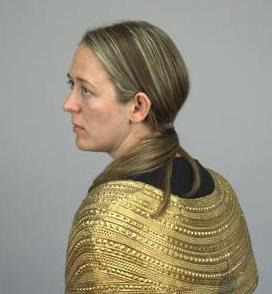The Golden Ghost of Mold #3: The Golden Woman of Mold August 16, 2013
Author: Beach Combing | in : Contemporary, Modern, Prehistoric , trackbackIn two previous posts we have discussed the traditions (ahem) behind the Golden Ghost of Mold. Now we want to look at the person who was buried in the tomb and another problem for the Golden Ghost tradition: the tenant was almost certainly an itty-bitty Welsh woman rather than a mighty warrior. How do we know this? The skeleton has long since been lost, so there is not going to be any CSI style reconstruction. But there was a description of amber beads (a handful of which survive); and a bronze knife was certainly buried there. There was also a second golden object but only the smallest fragments of this have come down to us: it may have been a cloak or part of a cloak. The amber beads, the knife and the lack of a ‘proper’ weapon all suggest, through comparison with other nearby tombs, that the grave was for a woman.
The corselet, which would have fit only a small person, has been the subject of much debate over the years. It began its life as, according to the experts, a piece of armour. By 1904 the British museum guide suggested though that it was, instead, the peytrel that wrapped around the front of a pony. In 1954 Brian Hope-Taylor published an artist’s reconstruction of a Welsh warrior wearing the corselet, the pony was nowhere to be seen. Then, when in 2002, it was completely restored, a woman modelled the corselet: imagine the goose pimps as that was lowered onto your neck. As noted above a reassessment of the grave goods suggest that it is unlikely that a man would have been buried here. We have then presumably a Gwynedd princess who died before her time and who was buried with honour.
The other major change in understanding the object has been its revised date. The discoverers and their sponsors had imagined that this was a late Roman or a post Roman find and there was even a failed attempt to connect the prize to Benlli Gawr, a probably mythical fifth centry Welsh prince of Gwynedd: here we have a nice example of how drunks look for lost car keys under lamps, because that’s where they can see. Recent dating has pushed the coverlet back way before the Romans were even a glint in the eye of Bronze Age Italy. The coverlet and the burial are both consistent with entombment sometime between 1500 and 2000 B.C. The gold was probably Welsh and, it is alleged, alluvial. This causes all kinds of problems of its own. Thoughts on the above: drbeachcombing AT yahoo DOT com



